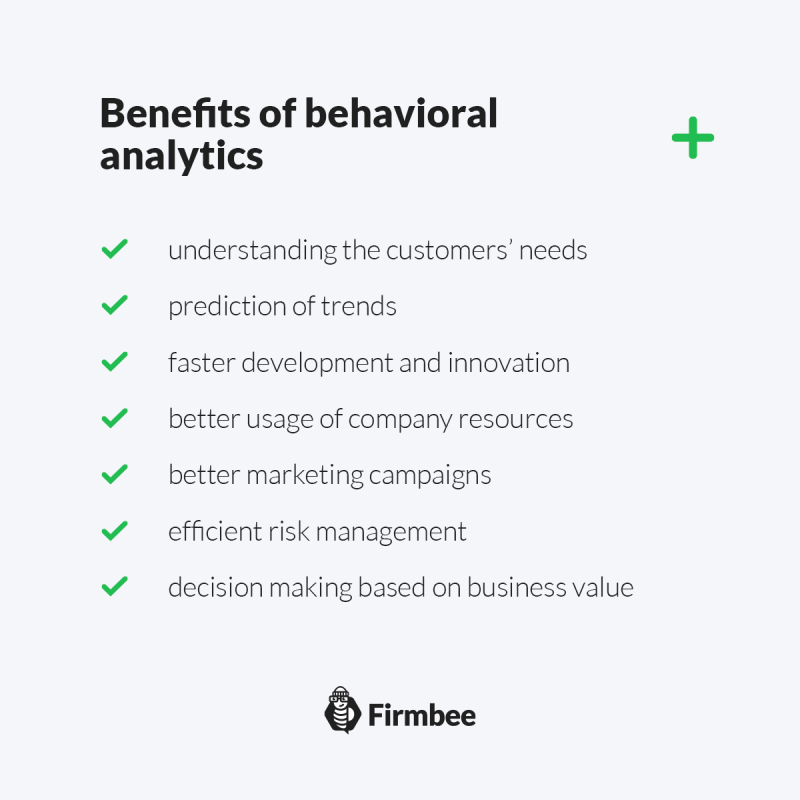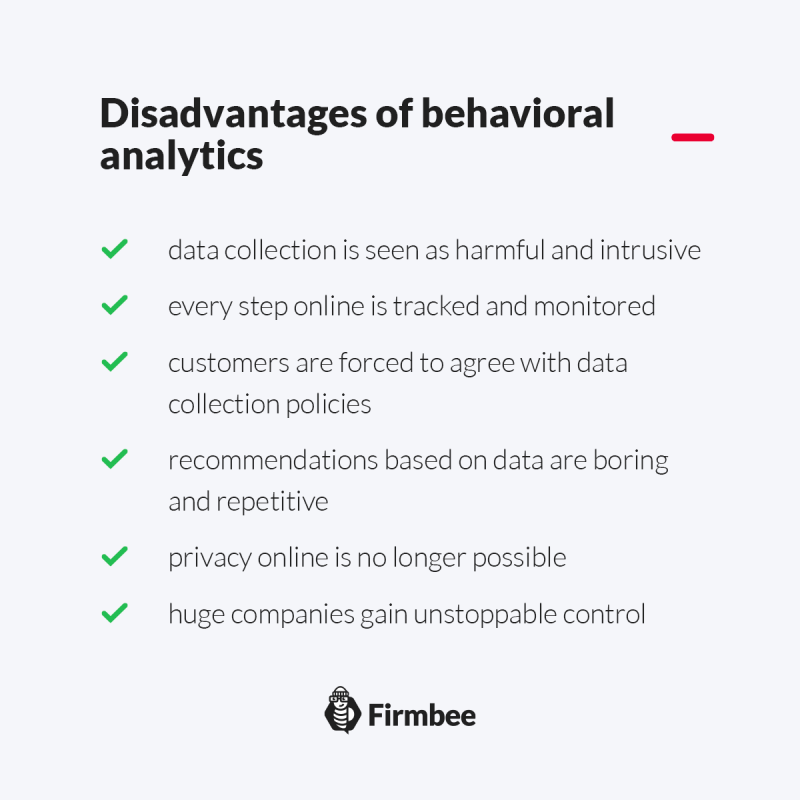What is behavioral analytics? Is it important to study customer’s behavior? What are the types of behavioral data? Is is possible to design great products without any insight into people’s behavior and values? What are the three stages of behavioral analytics? Read the article to find out more.
What is behavioral analytics?- table of content:
- What is behavioral analytics?
- Types of behavioral data
- Data collection and unification
- Three stages of behavioral analytics
- Behavioral analytics – summary
What is behavioral analytics?
Behavioral analytics is a new method of analyzing used for evaluation of interaction between the client and the web-based business. Behavioral analytics is used by the industries such as: e-commerce, gaming, and social media to reach specific business goals, usually to maximize the sales or increase the retention of the customers.
Behavioral analytics is a subsection of business analytics or data analytics. There are differences between those two approaches: business analytics is used to analyze past data with the use of statistical methods, while behavioral analytics focuses on registering and tracking client’s behavior.
Nowadays, companies which don’t collect and analyze big data seem to be unaware of intricate processes on the market and therefore may be unable to determine future trends and make sound business decisions. Behavioral analytics is one of many methods used by businesses to interpret big data related to behavior of masses and measure the impact of global processes that influence the market.


Types of behavioral data
Behavioral data is generated during user’s interactions with all digital channels of your business. The data include information about: page views, e-mail sign-ups, web-sites subscriptions, document downloads, communication with sales representatives, login frequency, time spent, location, clicks, mouse hovers, page scrolling, approved or declined card transactions and many more.
Behavioral data of the unique user allows the marketing specialist to see in details all the events that occurred during client’s activity in the Internet. The data is always linked to the single end-user, which can be either known by name (logged-in somewhere) or unknown and anonymous (not logged in anywhere).
The difference between data collected by Google Analytics and behavioral data collected elsewhere is only one: Google Analytics is used to track single sessions, while behavioral analytics is used to track individuals. Behavioral analytics data are registered in a form of an “event” accompanied with the information about other “properties” of the occurrence.
There are many sources of data that are of interest of behavioral analytics and those are: mobile applications, websites, gaming applications, retail sites, marketing automation systems, call centers, billing systems, help desks and CRM systems.
We see that there are clearly at least several types of data, but three types are distinguished most frequently: registered data, observed data and data related to the customer’s opinions:
- Registered data is all data related to an individual customer in CRM (Customer Relationship Management) systems. Such system manage all interactions of the company with its current and potential clients and contains not only personal data, but full record of all actions (services, campaigns) directed at the client by the company.
- Observed data is all data that is left by the client during his typical journey throughout the Internet. Most of the customer’s reactions to the different elements of the web-sites can be examined, collected and analyzed accordingly to give some initial clues about client’s needs and expectations.
- Customer’s opinion is all data gathered directly from the client in the form of surveys, questionnaires, web-site groups, workshops, e-mails and other forms of voiced statements. The customer may articulate his point of view either reactively (in response to our actions) or proactively (without being asked).
Data collection and unification
The most difficult part of behavioral data collection is related to the fact that all important data is to be found on many different, not connected platforms. So, financial data is stored on banking web-sites, surveys are processed through SurveyMonkey, social connections are seen on Facebookand Twitter, advertising campaigns are in Ad Word, while web-site analytics may be accessed in Google Analytics.
To avoid spending endless hours on reconciling manually all those data, your marketing department should posses at least one behavioral analytics platform. There are many options on the market, just to name the few: Amplitude, Mixpanel, Totango, Indicative, Alteryx, or Woopra. Since new applications of that type are being developed each day, any marketer can find a solution that suits his needs. When all the revenue and cost data is linked together the actual ROI may be estimated in real time.
Three stages of behavioral analytics
There are three main stages of behavioral analytics process. The very first step is data collection. There is so many sources of data that it is not possible to enlist them all. Most of the data is left by the unaware client during his or hers actions in the Internet. The data is left in the form of cookie files and when once recorded it may be analyzed and shared further.
The second step deals with segmentation of data. All the data has to be divided into smaller chunks that can be placed into certain categories related to predesignated criteria. One set of data may be processed in many ways hence the segmentation may have several different outcomes.
The third step of behavioral analysis is a stage of implementation. The data is used to adjust the content of the web (advertisement too) to customer’s needs, views and preferences. The client is targeted individually and is being presented with the information directed at him specifically.
Behavioral analytics – summary
Behavioral analysis is a new form of research used in marketing to find out more about customer’s engagement with a product or a company. During the process of behavioral analysis vast, raw data related to the client’s behavior is being collected. All the data has to be segmented accordingly to our research needs. The discoveries of the analysis are being used to contact the client directly with the new, redesigned offer, that is fully-adjusted to his needs.
Behavioral analysis allows managing directors of marketing departments to make sound and reliable business decisions based on detailed calculations and exact data, therefore it allows to save the resources at the same time increasing rates of client’s: engagement, conversion and retention.
If you like our content, join our busy bees community on Facebook, Twitter, LinkedIn, Instagram, YouTube.
Author: Zofia Lipska
With over 10 years of experience in digital marketing, Sophia not only knows the rules of this industry but above all knows how to break them in order to achieve outstanding and creative results.


















